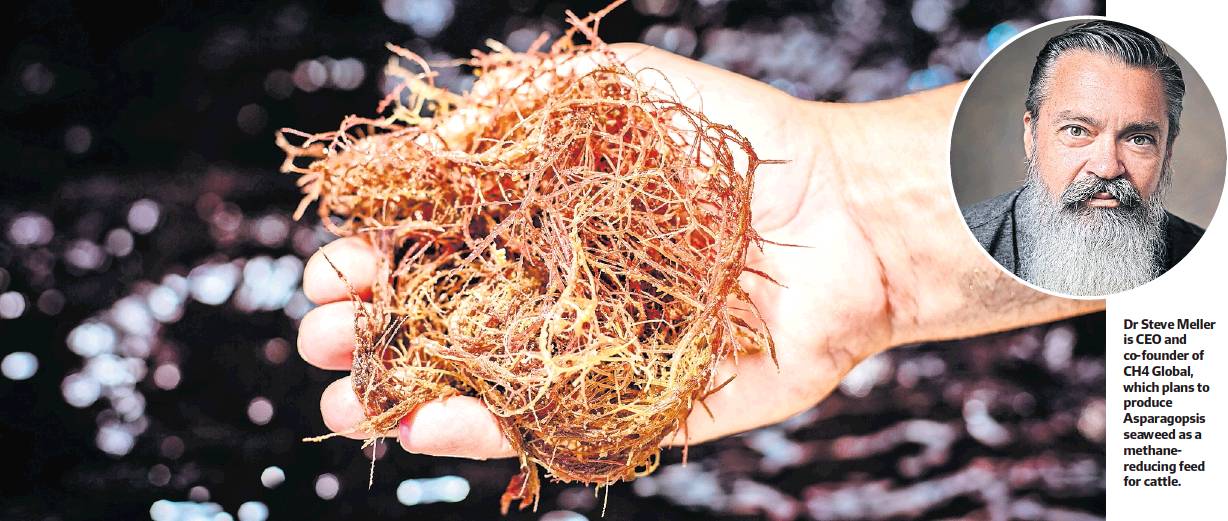An emissions solution to ruminate on
A nice long burp after a good meal may be satisfying for a cow but the methane contained therein is a menace.
The greenhouse gas is 86 times more potent than carbon dioxide at warming the atmosphere over a 20-year horizon, according to the Intergovernmental Panel on Climate Change (IPCC).
Livestock is responsible for 14.5 per cent of global anthropogenic greenhouse gas emissions, and one of the most destructive of those emissions is methane.
A recent report issued by the Climate and Clean Air Coalition stated: “Our best shot to slow climate change now [is to] cut methane”.
CH4 Global, a company headquartered in the United States with wholly-owned subsidiaries in Australia and New Zealand, is working on a solution that could help save the beef cattle and dairy industries, as well as the planet.
The company is aiming to aquafarm commercial quantities of a type of red seaweed, known as Asparagopsis, which is native to Australian and New Zealand waters. Their initial foray is in Australia and New Zealand, but their focus is global, scaled production and impact on climate change through key partnerships on every continent.
“Our vision is zero-methane agriculture,” says Dr Steve Meller, CEO and co-founder of CH4 Global. “Multiple feed trials conducted in both the USA and Australia have shown up to a 90 per cent reduction in methane from cows consuming as little as 50 to 100 grams of Asparagopsis in their daily feed.
“Our goal is to establish sustainable production and distribution of Asparagopsis-based products to impact climate change urgently and globally.’’
There are about 1.5 billion cattle in the world, and that number is rising with increasing demand for beef and dairy products. Every cow releases 70 to 120 kilograms of methane annually. Together with other grazing animals, cows contribute about 40 per cent of the methane that is pouring into the atmosphere and driving global warming.
The active ingredient in Asparagopsis is a compound called bromoform (CHBr3 for the chemically-minded), which disrupts the enzymes in the cow’s stomach that produce methane gas during digestion.
“CH4 Global is working to make Asparagopsis aquaculture a reality as soon as possible,” says Dr Meller. “We are focusing on developing hatcheries, growing, processing and formulating the Asparagopsis to create final products, all at the same time from our newly built market demonstration facility in Adelaide.
“We have a team of people managing the technical, commercial and financial considerations, all of whom are experienced in bringing new products to the world. We will be producing commercial quantities for supply to aligned partners by late 2022.”
As it progresses the regenerative, economic, social and environmental benefits offered by Asparagopsis towards a commercial reality, CH4 Global is tackling its goals based on three core tenets: urgency, farmers and partnerships.
Dr Meller explains: “First, we must act with urgency as we don’t have much time for scaled impact on climate change.
“Second, we must ensure the resulting products are easy for farmers to adopt, both practically and financially. And third, we must form partnerships to accelerate our impact.
“We have already established a partnership with the Narungga Nation Aboriginal Corporation to farm Asparagopsis approximately 7 kilometres north-west of Port Victoria in South Australia. We also have off-take agreements in place with meat processors in Australia ready to take our product once it’s ready.
“Our initial focus is Australia and New Zealand, the native home of Asparagopsis, as we plan to have our first product ready for market in 2022. We are now working on supply chain optimisation and developing a reliable, repeatable manufacturing blueprint to scale globally in 2023 and beyond.”
According to Dr Meller, the latest UN Emissions Gap Report suggests that even if all countries meet their Paris Agreement goals, by the year 2030 there will still be an enormous annual shortfall in the levels of emissions reduction required to keep the planet below 2 degrees warming by 2100.
Further underscoring the opportunity and impact, authors of the recent report stated that “methane is the single biggest lever for climate change impact in the next 25 years”.
“Slashing methane emissions from cattle on such a large scale could close most of that emissions reduction gap,” Dr Meller says. “Drastically reducing methane from ruminant livestock is doable and would substantially address the immediacy of the current climate crisis and allow time for the approaches for reductions of CO2 to be realised. It’s not a matter of one or the other – we must achieve scale for both methane in this decade and CO2 reductions in the following decades.’’
It’s a huge goal and an enormous undertaking. To facilitate speed and focus, CH4 Global is currently raising funds from global investors that will enable it to bring the aquaculture, processing, formulation and, importantly, its local and global partners to commercial reality in late 2022.
“Asparagopsis is a viable solution that can be implemented today, and thereby buy time for other decarbonisation technologies to be scaled up,” says Dr Meller.
And the Australian government recognised this potential in this year’s budget, specifically identifying agricultural feed technologies as a priority within its $1.2 billion spending plan to support the development of technologies to reduce carbon emissions.
“Australian farmers – and cows – have the opportunity to lead the world and make a real difference.”
